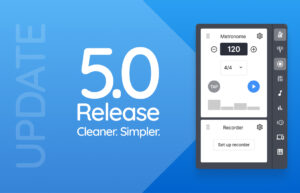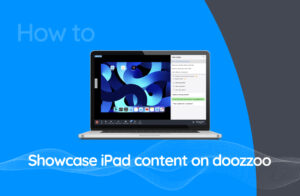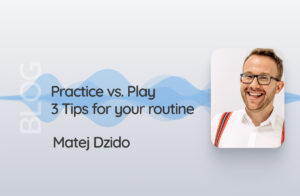Dear doozzoo Blog readers,
A few years ago, I had reservations about offering my piano lessons online. Today, with a smile on my face, I look back and share this journey with you. Four years before the pandemic, two of my piano students from Salzburg, who enjoyed weekly in-person piano lessons, moved to Sydney, Australia. They wanted to continue having me as their piano teacher. At that time, I was a piano student at the Mozarteum University in Salzburg, relying on the income from teaching to finance my piano studies. Simultaneously, I was captivated by the idea of being able to continue teaching over such a long distance and supporting my students in their piano journey, even from afar.
The following week, we arranged our first online session (back then, using Skype). After that, it became clear that while it could work, it would require additional technical resources to conduct diverse and engaging piano lessons online. At that time, I was not familiar with doozzoo. After a few nights of research, I set up a 360-degree streaming studio to ensure state-of-the-art audio and video transmission, providing my students with the best online learning experience. The compliment I received in the subsequent session was unexpected: “Hey Matej, this is so cool! Apart from not being physically present, everything else feels just like classical offline piano lessons. Amazing!” said my student, sitting in Sydney in front of her piano.

Master’s Studies during the 2nd Lockdown
Two years later, the time had come for my master’s thesis. My goal for the thesis was to delve deeper into online and in-person piano instruction. Besides examining free YouTube learning videos and various learning algorithm-based apps regarding their pedagogical concepts, the focus was on a 6-month study involving two groups of students. Sixteen students were divided into two groups. Without any musical background, they all had one wish: to learn to play the piano. The aim was to compare the learning opportunities of today as authentically as possible. Group A followed the traditional path of piano instruction: they received 30 minutes of individual lessons per student once a week, personally supervised by me. Group B learned independently, using current learning apps available on the market or YouTube videos. Our common goal was to perform a Christmas piece of their choice for each other by Christmas. The progress was documented through video, written protocols, and telephone calls. The results of my study were surprising:
In Group A, all eight students could play “Jingle Bells” fluently from beginning to end without mistakes. In Group B, three out of eight students had given up after three weeks, four could play the right hand somewhat error-free, and one could not participate due to scheduling conflicts. I subsequently held reflective discussions with each student from Group B to understand why:
a) Three students had quit after three weeks.
b) The rest could mostly play only the right hand.
All eight students emphasized missing the pedagogical structure in the long run. They needed to figure out what to practice next and missed feedback.
This sparked the idea: “Okay, a pedagogical structure can also be ‘pre-fabricated.’ Pedagogical concepts could be developed based on well-produced educational videos, allowing students to shape their learning journey flexibly. Additionally, a professional partner could provide group and individual coaching, enabling latency-free, professional coaching from anywhere in the world.”
I came across doozzoo through my former study colleague, Aloisia Dauer. I was fascinated by the holistic pedagogical possibilities offered by doozzoo. Integrating my Pianofly Online Academy and doozzoo greatly enriches every student.
My Favorite Feature of doozzoo in Online Piano Lessons:
I want to share with you three practical ways I frequently and joyfully utilize my two favorite features—doozzoo’s audio player and audio recorder—in my individual and group coaching sessions:
Latency-free Playalongs for Enhanced Musicality
Chic Corea once said in an interview, “The best progress you make is while playing live with your role model musician. Imagine you want to learn from Herbie Hancock, for example, then go and play with him.” What could be better than importing a play-along by Herbie Hancock into doozzoo and playing the piano part in real time? It gives you a sense of phrasing, tonal language, expression, timing, etc. This is where doozzoo comes into play: doozzoo is the first and only video conferencing system that offers a remote-controllable, integrated audio player. Thanks to the media library, I no longer need to send audio files to my students; instead, I can play them directly during the lesson, adjusting the tempo and pitch as required. The high-quality playback remains intact, allowing me to hear students synchronously due to local latency compensation.
Recording and Playback in Real-Time
Imagine this teaching situation: your piano student is currently learning a new sonatina by Diabelli or Mozart, and the ensemble playing seems challenging at their current level. Here, the recorder comes in handy. I can casually record my left hand while simultaneously playing it for my student. Afterward, I play back the recording, and my student plays along with their right hand. This way, the student can focus on their right hand comfortably, feeling that “it sounds right,” and they always have the result in their ear. An additional advantage for all teachers is that, over time, you build a collection of exercises that can be used for other students.
Pitching Audio Files for Better Improvisation / Transposition
Let’s say we want to practice free piano playing, improvisation, or transposition. I have prepared a custom backing track for my students and want them to play a melody in a specific interval, higher or lower. For practice at home, the student can pitch my audio backing track accordingly and refine their improvisation. Simultaneously, they receive real-time feedback when practicing transposing a piece. They hear the deviation wonderfully.
I am delighted to have written this blog article for doozzoo, sharing my experiences with you. I wish all instrumental teachers and music schools continued success with your students. I hope my contribution has sent a bit of inspiration and motivation into the world :-)
Yours sincerely,
Matej
Pianist, Piano Coach, and Founder of Pianofly
About the Author

Matej Dzido completed his studies in instrumental and vocal pedagogy at the Mozarteum University Salzburg, specializing in piano under the guidance of Prof. Dr. Stan Ford, earning unanimous distinction. Since 2015, he has been working as a freelance product specialist and demonstrator for various Yamaha keyboard instruments. Currently, Matej is on tour with his latest concert project, “Beethoven in Havana,” performing both nationally and internationally. Additionally, he conducts workshops and masterclasses while serving as the founder of the Pianofly Online Academy since 2021. Notably, his students have achieved multiple 1st prizes at the prestigious youth competition, Prima La Musica.











